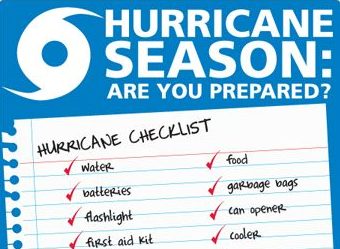
Hurricane Matthew is making it’s way through the Caribbean and now towards the Coastal U.S. The category 4 hurricane shows no signs of slowing down. FEMA, the Federal Emergency Management Agency, lists the following tips:
*Listen to the radio or TV for information.
*Secure your home, close storm shutters and secure outdoor objects or bring them indoors.
*Turn off utilities if instructed to do so. Otherwise, turn the refrigerator thermostat to its coldest setting and keep its doors closed.
*Turn off propane tanks.
*Avoid using the phone, except for serious emergencies.
*Moor your boat if time permits.
*Ensure a supply of water for sanitary purposes such as cleaning and flushing toilets. Fill the bathtub and other large containers with water.
Individuals should visit www.ready.gov or www.listo.gov to learn these and other preparedness tips for tropical storms or hurricanes. If the storm is expected to affect your area, know your evacuation zone and follow the direction of local or tribal officials if an evacuation is ordered for your area.
If you will be evacuating, contact family and friends to let them know you are leaving and where you’re going; and take your pets with you or pre-identify a pet-friendly safe location like a pet friendly hotel or shelter.
Create a household inventory: For insurance purposes, be sure to keep a written and visual (i.e., videotaped or photographed) record of all major household items and valuables, even those stored in basements, attics or garages. Create files that include serial numbers and store receipts for major appliances and electronics. Have jewelry and artwork appraised. These documents are critically important when filing insurance claims.
Other steps to take right now to protect property are:
- Make sure your sump pump is working, and then install a battery-operated backup, in case of a power failure. If you already have a battery backup, install fresh batteries. Installing a water alarm will also let you know if water is accumulating in your basement.
- Clear debris from gutters and downspouts. Clear storm drains in the street or near your home of leaves and debris.
- Move electronics, valuables, and important documents to a safe place.
- Roll up area rugs, where possible, and store them on higher floors or elevations. This will reduce the chances of rugs getting wet and growing mold.
- Shut off electrical service at the main breaker if the electrical system and outlets will be under water.
- If you incur expenses due to protecting your home in preparation for coming storms and flooding – such as purchasing sandbags – you may be able to file a claim against your National Flood Insurance Program flood policy for reimbursement. Call your insurance agent to discuss your coverage and learn more.
There is the potential for flooding with this storm. Driving through a flooded area can be extremely hazardous and almost half of all flash flood deaths happen in vehicles. When in your car, look out for flooding in low lying areas, at bridges and at highway dips. As little as six inches of water may cause you to lose control of your vehicle. If you encounter flood waters, remember – turn around, don’t drown.
Get to know the terms that are used to identify severe weather and discuss with your family what to do if a watch or warning is issued:
For a hurricane:
- A Hurricane Watch is issued when a tropical cyclone containing winds of at least 74 MPH poses a possible threat, generally within 48 hours.
- A Hurricane Warning is issued when sustained winds of 74 MPH or higher associated with a tropical cyclone are expected in 36 hours or less. A hurricane warning can remain in effect when dangerously high water or a combination of dangerously high water and exceptionally high waves continue, even though winds may be less than hurricane force.
For a tropical storm:
- A Tropical Storm Watch is issued when tropical cyclone containing winds of at least 39 MPH or higher poses a possible threat, generally within 48 hours.
- A Tropical Storm Warning is issued when sustained winds of 39 MPH or higher associated with a tropical cyclone are expected in 36 hours or less.
For flooding:
- A Flood Watch is issued when conditions are favorable for flooding.
- A Flood Warning is issued when flooding is imminent or occurring.
To learn more about what to do before, during and after severe weather, visit www.Ready.gov.
Check for updates and more information on Twitter @ReadyGov or @TheBurtonWire.









